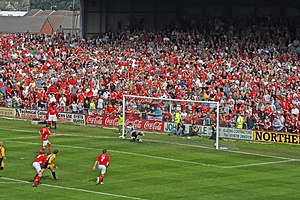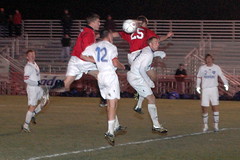Successful soccer competition requires players to cover 10-12 km of moderate running whilst having the ability to react and perform intense efforts such as sprinting, jumping and kicking. The ’intermittent activity’ that characterizes soccer increases energy expenditure and fatigue in athletes when compared to activities that are more continuous such as running or cycling.
Fatigue in soccer is evident with reports that running distances in the second half of games can be 300 meters lower than in the first half of games. Most of this lower work rate occurs in the last 10 minutes. This will impact on performance as players cannot supply the intense efforts needed to perform important actions such as sprinting, tackling, shooting etc and will have a decreased ability to close down the opposition and support other players.
A number of factors can cause this including dehydration and lowered muscle glycogen levels. Research has shown that if soccer coaches can minimize the effect of these 2 processes then soccer players will be able to increase the distances they run in games and have the sustained ability to produce intense efforts towards the end of games.
Decreased/Exhausted Muscle Glycogen levels
Muscle glycogen is stored in the body when carbohydrates are consumed in the diet and supplies energy for both high and low intensity activities. Near empty muscle glycogen stores will not only affect physical performance on the pitch but also the players ability to concentrate and perform fine skills. Saltin’s (1973) classic study (see table 1) highlighted the effects of low pre-match glycogen levels (through a low carbohydrate diet) on performance during soccer competition. He highlighted that a low carbohydrate diet caused low muscle glycogen levels prior to a soccer game, which caused players to walk more during the game and sprint less. This also had an impact on the distances covered. A high carbohydrate diet meant players covered 12000 meters but a low carbohydrate diet meant players only covered 9700 meters and covered 1500 meters less in the second half than they did in the first half showing fatigue occurred.
Dehydration
During soccer matches fluid loss will be produced due to the demands on respiration and increased sweating in an attempt to cool the body. Depending on the conditions and temperatures during a soccer match fluid loss can correspond to 2-5 kg of body mass loss. In an average 70 kg footballer this can reflect a 3-5% reduction in body mass, which has been linked to a decrease in endurance capacity (therefore lowered running distances), 35% decrease in high intensity exercise (therefore lower sprinting, jumping, kicking levels) and difficulties in concentration.
Therefore you as a soccer coach must design a way to minimize this occurring by ensuring that your players engage in and understand beneficial nutritional strategies to maintain muscle glycogen and prevent dehydration.
Pre Match Nutrition Strategies
Post Match Nutrition Strategies
Fatigue in soccer is evident with reports that running distances in the second half of games can be 300 meters lower than in the first half of games. Most of this lower work rate occurs in the last 10 minutes. This will impact on performance as players cannot supply the intense efforts needed to perform important actions such as sprinting, tackling, shooting etc and will have a decreased ability to close down the opposition and support other players.
Decreased/Exhausted Muscle Glycogen levels
Muscle glycogen is stored in the body when carbohydrates are consumed in the diet and supplies energy for both high and low intensity activities. Near empty muscle glycogen stores will not only affect physical performance on the pitch but also the players ability to concentrate and perform fine skills. Saltin’s (1973) classic study (see table 1) highlighted the effects of low pre-match glycogen levels (through a low carbohydrate diet) on performance during soccer competition. He highlighted that a low carbohydrate diet caused low muscle glycogen levels prior to a soccer game, which caused players to walk more during the game and sprint less. This also had an impact on the distances covered. A high carbohydrate diet meant players covered 12000 meters but a low carbohydrate diet meant players only covered 9700 meters and covered 1500 meters less in the second half than they did in the first half showing fatigue occurred.
Dehydration
During soccer matches fluid loss will be produced due to the demands on respiration and increased sweating in an attempt to cool the body. Depending on the conditions and temperatures during a soccer match fluid loss can correspond to 2-5 kg of body mass loss. In an average 70 kg footballer this can reflect a 3-5% reduction in body mass, which has been linked to a decrease in endurance capacity (therefore lowered running distances), 35% decrease in high intensity exercise (therefore lower sprinting, jumping, kicking levels) and difficulties in concentration.
Therefore you as a soccer coach must design a way to minimize this occurring by ensuring that your players engage in and understand beneficial nutritional strategies to maintain muscle glycogen and prevent dehydration.
Pre Match Nutrition Strategies
- Players should be fully hydrated prior to a match by consuming adequate amounts of water 2 days before the match (hydration can be checked by players looking at their own urine, if its not transparent or straw colored then water consumption should be increased).
- A pre-match meal should be eaten 3 hours prior to competition (eating later than this means players could experience intestinal problems, eating earlier may cause players to be fasting their glycogen stores prior to the match).
- Ideally players should eat 4 g /kg of body weight of carbohydrate (representing 280 g of carbohydrate for a 70 kg player) before the match with a little protein and little to no fat.
- An ideal meal would have 2 types of carbohydrate such as vegetables and potatoes or vegetables and pasta with a little light meat such as chicken or fish if desired.
- If players cannot eat enough solid carbohydrate before the match then a carbohydrate drink could also be added to the meal.
- Most teams do not have the facility to provide a set pre-match meal to their players that follow these principles. Therefore the coach needs to educate their players about these principles, so that they can be followed at home prior to a game without the coaches guidance.
- Players should drink a carbohydrate drink immediately before kick off or no later than 30 minutes before kick off (this should a 5-10% solution e.g. 500 ml drink should have at least 25-50 grams of carbohydrate in).
- Players should attempt to stay hydrated and top up their glycogen levels.
- Ideally players will drink 200 ml every 15-20 minutes during the match. Therefore the coach must get players to drink whenever there are pauses in the game such as injuries.
- It has been debated whether players should drink water or a carbohydrate drink (drinking water will mean it is emptied from the stomach from the intestine quicker, but a carbohydrate drink will top up glycogen levels).
- The basic principle adopted is during the 1st half players consume a carbohydrate drink that is 2-3% (will reflect 10 grams of carbohydrates per 500 ml)
- At half time players should drink a carbohydrate drink that has 6-7% carbs and also consume a small amount of solid quick release carbohydrates such as sweets.
- In the second half players should continue consuming the 6-7% carbohydrate solution.
- Players should have consumed 600-800 ml of fluid through the match.
Post Match Nutrition Strategies
- Nutrition immediately after the match will have a huge impact on how players recover from the match.
- Players need to consume 10 g/kg body mass of carbohydrate over the 24 hours after the match (reflecting 700 grams of carbohydrate in our ‘average’ 70 kg footballer).
- Players also need to consume 1.5 x body mass loss of fluids (e.g. if our player weighed 70 kg prior to the game and weighs 67.5 kg after the match then 3.75 liters of fluid should be consumed over the next 12 hours - remember the sodium!)
- 2 hours after a match reflects the time when the body will respond the most to proper nutrition therefore this is the time when coaches should get players to eat and drink maybe with a team pre-match meal.
- However the sooner within this 2 hours you can get players to hydrate and eat the better, e.g. players should be encouraged to consume a carbohydrate drink when coming off the pitch.
- Over this 2-hour period 2-3g/kg body mass of carbohydrates should be eaten with at lest 6 grams of protein being consumed.
- Players should therefore drink a 10% carbohydrate drink immediately after a game and then eat a meal that has quick release carbohydrates in such as mashed potato and white rice including some protein such as a chicken breast or some tuna.
- Due to the rigors of the game some players may not be able to ‘stomach’ solid foods therefore they should be encouraged to drink large amounts of a carbohydrate drink to ensure muscle glycogen is replenished.






























